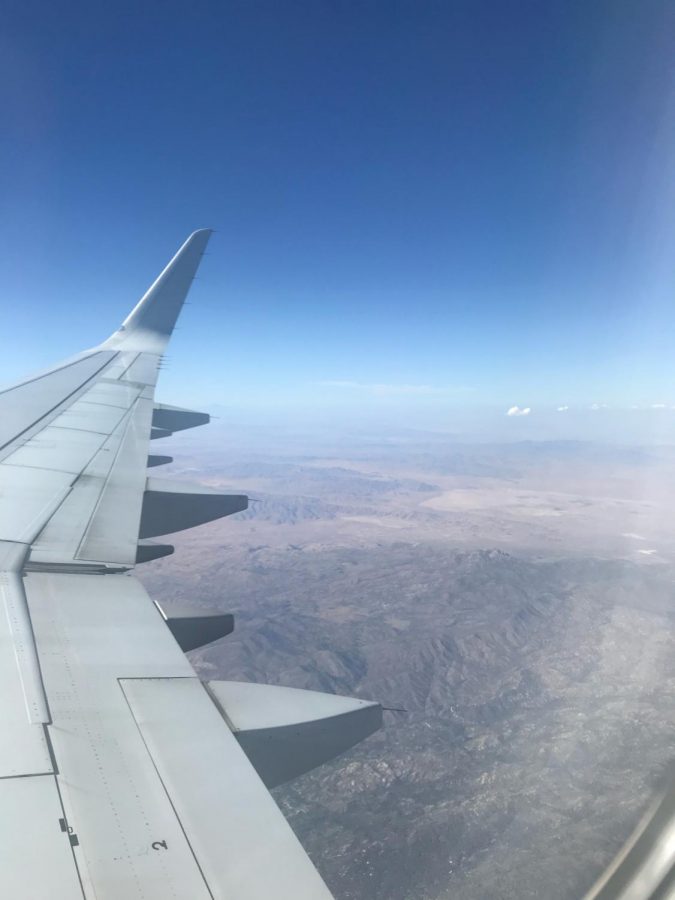Traveling During a Pandemic: the Good and the Bad
View from an airplane window.
September 14, 2020
Los Angeles, CA — Imagine this: you are heading to the airport on a warm summer evening, about to embark on the vacation of a lifetime. You can smell the adventure that awaits you, but as you roll down the car window and close your eyes to smell the summer breeze, you hear the first long drawl of a car horn that snaps you right out of your daydream. You open your eyes and find yourself at the entrance to the airport where cars snake around the road. Traffic becomes congested, the incessant honking from other cars and the road rage intensifies, there is a scramble of people hurriedly trying to make their flights on time.
If you are from Southern California, you know just the place: Los Angeles International Airport (LAX), notorious for its congested nature and most likely for bad memories of having to loop around the airport complex innumerable times when trying to pick up a relative.
Is it possible to imagine a trip to LAX where there are virtually no cars, no wait, and no lines before security? For people who are traveling in the middle of a pandemic, yes, it is.
Amidst the COVID-19 pandemic, there has been widespread implementation of social distancing and mask-wearing mandates in order to slow the spread of the disease. Although air travel has significantly decreased due to the pandemic, there are still individuals who are catching flights for business or personal reasons.
At airports, the epicenters for travel, the accommodations can be tight, which increases the risk of spreading the virus. What protocols can travelers expect to encounter at the airport to slow the spread and what does travel really look like today in the midst of a global pandemic?
On the shuttle ride from a parking garage to LAX to catch a flight from LAX to Chicago O’Hare, it was impossible to practice social distancing. Despite the close quarters of the shuttle, everyone was wearing face coverings and did their best to put at least one seat of distance between themselves and another party.
The typical traffic and backup on the roads leading to the terminal were missing and the airport appeared almost deserted. Arriving curbside within a matter of minutes, the usual stressful search to find a spot to unload was non-existent.
Once inside the airport, there was an observable decrease in foot traffic: there were no lines to print boarding passes, check bags, or to go through security. Passengers breezed through to the gate almost immediately. Another sign of the times: there were reminders posted throughout the terminal urging passengers to wear face coverings, keep 6 feet away from others, wash their hands frequently, and monitor their health.
To reduce the contact that passengers would have with others in the aircraft, passengers boarded starting with the last rows of the plane and continued to the front in small groups. All passengers were given disinfectant wipes as soon as they boarded and United Airlines provided each passenger with a plastic bag filled with water, snacks, and an additional sanitizing wipe during the flight. Travelers will likely be disappointed if they expect planes to be mostly empty: the flight to Chicago O’hare was almost completely full.
United Airlines has implemented disinfecting protocols on their aircraft between every flight such as the disinfection of all surfaces in the plane that are commonly touched by passengers and the use of electrostatic disinfectant spray inside the plane. Additionally, all passengers must wear a face covering or mask inside the plane and are provided with masks if they do not already have one. United Airlines also uses HEPA filters on their aircraft to provide a more sterile environment and decrease the risk of the spread of the virus.
Traveling during a global pandemic may be necessary for some, and despite it often being impossible to maintain six feet apart from others, airports and airlines such as United are doing their best to keep passengers safe and healthy. Although you may be able to live out the fantasy of arriving at the airport with no congestion, it may be more difficult to experience the heart-pounding excitement of frolicking across LAX’s empty hallways and having an entire airplane row to yourself.









Robert Sherman • Sep 17, 2020 at 11:30 pm
Clever idea to have the opening paragraph set up normal expectations for a trip and then contrasting these expectations with the reality of the pandemic in the rest of the article. Nicely executed.